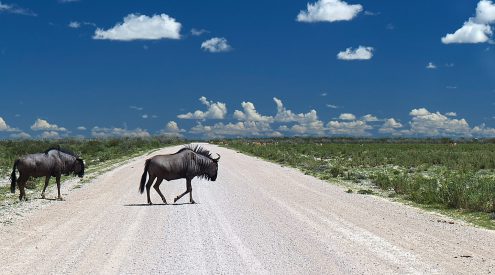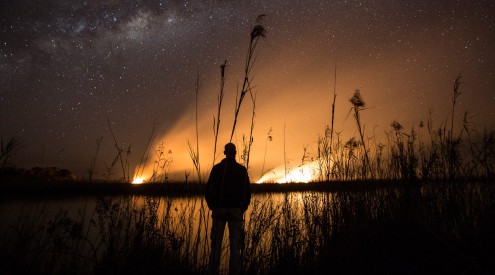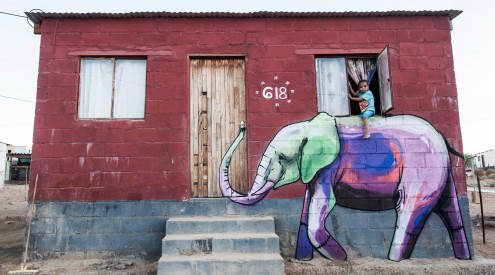Greetings again from the Horn of Africa – the fascinating area that contains the countries of Eritrea, Djibouti, Ethiopia and Somalia. We’re still zigzagging down the Great African Rift Valley and feeling the pace, all of us a bit travel worn. But everybody’s strong in the knowledge that we’ve got just a short distance of this section of the Rift Valley still to complete before getting to Addis Ababa and the end of chapter one of our expedition.
Peace and Goodwill
On every expedition we carry a Scroll of Peace and Goodwill. These have been messaged by chiefs, ambassadors, government officials, governors, Nobel Peace Prize laureates Nelson Mandela and Archbishop Desmond Tutu, and even on one occasion by a near naked Himba girl who endorsed the scroll with a simple red-ochered handprint. Today’s message is from an Afar tribe M.P. who scribbles… ‘Welcome to the land of Lucy…’ – he’s referring to the 1974 discovery of an almost complete 3.5 million years old hominid skeleton named ‘Lucy’ – the song ‘Lucy in the Sky with Diamonds’ was playing in the archeologists’ camp shortly after the find close to where our convoy of three expedition Land Rovers now travel in a cloud of dust along the floor of the Rift Valley’s Afar triangle. It’s close to sunset but Ali our guide warns us that it’s too dangerous to camp wild in this area. ‘There’s bad blood between the Issa and the Afar – it’s about livestock, available water and grazing rights.’ We push on into the night.
Still zigzagging down the Rift
We reach Awash Station on the old 1929 French-built railway line that joins Addis Ababa to Djibouti. The train no longer operates but we find rooms in the old Greek owned railway hotel called ‘Buffet Awash’. It was from here in 1932 that the great British explorer Wilfred Thesiger departed in a caravan of 22 camels, 32 men, some Somali cameleers, 15 khaki clad soldiers and an Afar hostage to ensure their safety. It is hard to believe that as recently as 1932 no expedition had survived a journey through these still dangerous lands of the Afar tribe who collected the testicles of their enemies as trophies. Our next objective is a 300km dash through the lands of the Nilotic Oromo people (also known as the Galla) to the ancient walled city of Harar high up on the opposite Rift Valley escarpment overlooking Djibouti, Somaliland and theDanakil plains.
Ancient Harar – 9°19’N 42°7’E, Elevation 1885 metres
For many years I’ve dreamt about one day reaching the ancient fortified trade terminus of Hara, considered to be the fourth holy city of Islam after Mecca, Medina and Jerusalem. On foot we pass through the Showa Gate, enclosed by the crumbling medieval walls, over 300 cobbled alleyways connect the rabbit warren of hobgoblin stalls, shops, white washed homes, mosques, shrines and markets that are home to some 20 thousand Harari inhabitants. What’s so cool about this place is just how friendly and relaxed everybody is. In the heat of the afternoon the men gather in the shade to chew the green narcotic ‘leaves of paradise’ called chat or qat. Here on the Horn of Africa is a way of life. Old men whose teeth have rotted away, resort to using a small mortar and pestle to pound a green ‘chat’ paste which they rub onto their gums. I’d prefer to gargle with Captain Morgan,’ saysMike Nixon with a grin.
The after effects of honey wine
The first European to enter the then ‘forbidden city’ was the British explorer Richard Burton, who trekked from Berberer on the Somali coast in 1855. He survived to write that Harar was a great ‘halfway house’ for slave caravans, making their way from the interior to the Red Sea. His notes on the local honey-wine read… This is the Abyssinian “Tej… some write it “Zatsh.” At Harar it is made of honey dissolved in hot water, strained and fermented for seven days with the bark of the Kudidah tree. Every traveller has praised the honey-wine…, and some have not scrupled to prefer it to champagne. It exhilarates, excites and acts as an aphrodisiac; the consequence is, that at Harar all men, pagans, sages, priests and rulers drink it… We try it, it makes us talk loudly with numerous visits to the loo – we’ll keep you posted.
Camel meat and Ethiopian coffee
Still in the old walled city of Harar, Mashozi bargains for colourful cloth and a curved Afar dagger in a decorated leather scabbard whilst I buy camel meat from the Muslim market, where the butcher throws bits of intestine into the air to be caught by swooping yellow-billed kites.
Later we gather in the town square to drink strong black Ethiopian coffee from small china cups. (Harar coffee is said to be the best in the world.) That’s when ‘Ali the Afar’ tells us about the other Harar residents who at night gather at the edge of Jugal (the other name for the walled city) waiting for the humans to go to sleep so that they can prowl the streets.
The spotted Hyenas of Harar
‘Even the walls of the city have low doorways that allow the hyenas to pass,’ says Ali. ‘Hyenas are part of life here, they keep out the bad spirits (Djinns) and at night they eat the scraps and the garbage left out for them. They don’t trouble the people. There’s even man who feeds them meat with his own mouth.’ And so as night falls over the walled city of Harar we find ourselves back in the Land Rovers on our way to meet ‘Abbas the Hyena Man who’ve taken over from his father Yusuf who was the hyena man for 40 years! We don’t know what to expect.
Abbas the Hyena Man
With only the expedition Land Rover’s headlights to illuminate the crazy scene, we watch in amazement as Abbas the Hyena Man calls into the night. There’s that familiar whooping sound and hyena eyes shine in the dark, soon they are all around us. It’s breeding season so we must be careful, says Abbas, as the alpha male comes forward to snatch a piece of rotten camel meat from the end of a short stick held between Abbas’s teeth. He shouts out the carnivores’ names and I scribble in the expedition journal as he calls: Chalto! Chala! Ibsa! Ipsito! Jambo! Bruse! … and many more. Then the expedition members Mike Nixon and Willie Gwebu give it a go, the hyenas coming forward to greedily snatch the meat from their mouths – It’s bloody scary!. ‘Come, it’s your turn Pops, I need a piece to camera,’ says Ross. I shit myself! Sitting on a rock, the massively strong spotted hyenas all around me. Abbas parades the meat in front of my face – I hear the snap of their powerful jaws and smell the rotten meat. According to legend these wild hyenas are fed in good times so that in times of drought they won’t attack livestock or people (that’s if you’re not possessed by an evil Djinn). ‘Careful,’ says Mashozi, ‘you never know what they can find in your beard.’ So much still to see and do – we’ll keep you posted.
Sipfulls in the Rift Valley calabash
We survive the hyenas of Harar and back on the floor of the Great African Rift Valley at Awash, Mike takes off early by mountain bike and we do some Rite to Sight, Life Straws and United Against Malaria work with the local community. So continuing to use the adventure to improve lives. We meet up with Mike in the heat of the day. He’s sitting under an acacia tree playing bottle top drafts with Awash National Park rangers. They won’t let him ride any further. It appears there’s a danger of lions. Today is his last ride on this Rift Valley chapter. He’s been great company and will, I’m sure, be back. An armed ranger escorts us to the waterfalls on the Awash River below which there cruises a massive crocodile. We add some water to the calabash and then further down the Rift we add a sipfull of Lake Beseka water. It’s a beautiful area. Above the black lava encrusted lake there looms the active volcano of Fanteller and on the surrounding yellow grass plains we see Beisa oryx, long necked gerenuk and our first ever Soemmerings gazelle. These are the lands of the fierce Kereyu tribe and the men are noted for their hairstyles of short on top and huge afro on the sides. ‘Be careful taking photographs,’ warns Ali.
The Zen of Travel
Thanks to the Zen of Travel, a great expedition team and wonderful support from friends and sponsor partners, we’ve survived chapter one as we zigzagged across the sometimes dangerous Afar Triangle section of the Great African Rift Valley from Djibouti on the Horn of Africa to Addis Ababa, the capital of Ethiopia. Continuing to use the adventure to improve lives, chapter two of the expedition will take us South from Addis Ababa along the Ethiopian Rift Valley lakes all the way to Lake Turkana, the world’s largest desert lake, in Northern Kenya. As they say in the Ethiopian Amharic language, ‘Ameseghinalehu’ which means thanks. We could not have succeeded without your support.
Don’t miss out! Kingsley Holgate will be speaking in your city. Check out the 2012 dates here.
















